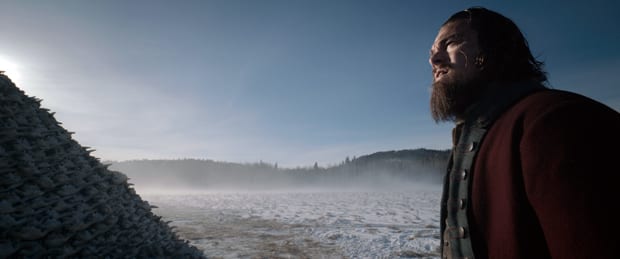 We’ve reached a level of technology where, if something can be imagined, folks in Hollywood can make it happen. The domination of digital effects, in the wrong hands, could result in technicians rather than artists overwhelming our moviegoing experience. (Let’s face it: That’s what superhero movies are.) But when you have a director like Alejandro G. Inarritu in control, the artistry remains intact. To steal from a superhero movie (by way of the Enlightenment), with great power comes great responsibility. And oh, what power is wrought by The Revenant.
We’ve reached a level of technology where, if something can be imagined, folks in Hollywood can make it happen. The domination of digital effects, in the wrong hands, could result in technicians rather than artists overwhelming our moviegoing experience. (Let’s face it: That’s what superhero movies are.) But when you have a director like Alejandro G. Inarritu in control, the artistry remains intact. To steal from a superhero movie (by way of the Enlightenment), with great power comes great responsibility. And oh, what power is wrought by The Revenant.
The victory of vision with a purpose is evident in almost every frame of this towering yet intimate epic. In the 1830s, trappers in the mountainous Midwest are dealing with Native American raiders. Maybe the trappers are the bad guys, invading sacred lands; maybe the Indians are, ambushing men with a fusillade of arrows while the sit unarmed in camp. Who is right isn’t the point; there’s conflict, and everyone is on edge, from the wily and self-interested trapper John Fitzgerald (Tom Hardy, in what may be the year’s best performance) to the methodical family man Hugh Glass (Leonardo DiCaprio), who lived with Indians (his teenaged son is on the safari with the white men) and understands the value of empathy. When Hugh is attacked by a bear — in what is the film’s most eye-popping and harrowing scene, one of the most viscerally arresting ever filmed — his survival puzzles his colleagues. Some (Fitzgerald most vocally) want to abandon him; the leader, though, believes he needs to be cared for until he dies … which should be soon.
But Glass doesn’t die that easy. He lives on, to the consternation of Fitzgerald, who plans to speed up nature … and commit heinous crimes in the process.
The Revenant is like Moby-Dick on land, a revenge movie about Glass’ determination not to be left for dead, and to take his pound of flesh from those who would deny him his humanity. For more than two and a half hours, Inarritu drags us through the snowy crags of the Rockies, through starvation, murder, animal attacks, manhunters and the interpersonal dynamics of post-Colonial America with a keenness and insight that feels continually authentic. That’s quite a feat, especially considering Inarritu’s last film, the Oscar-winning Birdman, was set in the constricting tableau of a Broadway theater, with only occasional forays down city streets in what appeared to be one continuous shot. His cinematographer, Emmanuel Lubezski, opens up the visuals of The Revenant in staggering ways, doing for the cold American frontier what Freddie Young did for desert vistas in Lawrence of Arabia. He should be coasting toward his third Oscar (he also shot Gravity) in as many years.
The performances are just as essential in convincing us, with DiCaprio conveying mostly with his eyes and body (he speaks only a handful of lines in the film) and Hardy, or course, the scariest villain this side of the Sith. The Revenant is the year’s most anguished masterpiece — Hollywood filmmaking at its very best.
Opens in wide release Friday.













